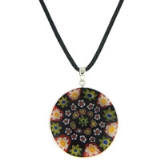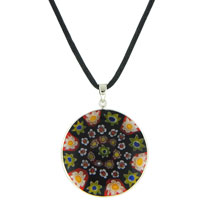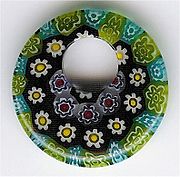
Millefiori
Encyclopedia


The term millefiori is a combination of the Italian
Italian language
Italian is a Romance language spoken mainly in Europe: Italy, Switzerland, San Marino, Vatican City, by minorities in Malta, Monaco, Croatia, Slovenia, France, Libya, Eritrea, and Somalia, and by immigrant communities in the Americas and Australia...
words "mille" (thousand) and "fiori" (flowers). Apsley Pellatt
Apsley Pellatt
Apsley Pellatt was an English glassware manufacturer and politician.The son of glassware makers Apsley Pellatt and Mary Pellatt, Apsley joined the family glass-making company of Pellatt and Green in 1811...
(in his book "Curiosities of Glass Making") was the first to use the term "millefiori", which appeared in the Oxford Dictionary in 1849. The beads were called mosaic
Mosaic
Mosaic is the art of creating images with an assemblage of small pieces of colored glass, stone, or other materials. It may be a technique of decorative art, an aspect of interior decoration, or of cultural and spiritual significance as in a cathedral...
beads before then. While the use of this technique long precedes the term millefiori, it is now frequently associated with Venetian glass
Venetian glass
Venetian glass is a type of glass object made in Venice, Italy, primarily on the island of Murano. It is world-renowned for being colourful, elaborate, and skillfully made....
ware.
More recently, the millefiori technique has been applied to polymer clay
Polymer clay
Polymer clay is a sculptable material based on the polymer polyvinyl chloride . It usually contains no clay minerals, and is only called "clay" because its texture and working properties resemble those of mineral clay...
s and other materials. Because polymer clay is quite pliable and does not need to be heated and reheated to fuse it, it is much easier to produce millefiori patterns than with glass.

History of Millefiori
The manufacture of mosaic beads can be traced to Ancient Roman, Phoenician and Alexandrian times. CanesCaneworking
Caneworking is a glassblowing technique that is used to add intricate patterns and stripes to vessels or other blown glass objects.Cane refers to rods of glass with color; these rods can be simple, containing a single color, or they can be complex and contain many strands of multiple colors in...
, probably made in Italy, have been found as far away as 8th century archaeological sites in Ireland, and millefiori was used in thin slices to brilliant effect in the early 7th century Anglo-Saxon jewellery from Sutton Hoo
Sutton Hoo
Sutton Hoo, near to Woodbridge, in the English county of Suffolk, is the site of two 6th and early 7th century cemeteries. One contained an undisturbed ship burial including a wealth of Anglo-Saxon artefacts of outstanding art-historical and archaeological significance, now held in the British...
.
The technical knowledge for creating millefiori was lost by the eighteenth century, and the technique was not revived until the nineteenth century. Within several years of the technique's rediscovery, factories in Italy
Italy
Italy , officially the Italian Republic languages]] under the European Charter for Regional or Minority Languages. In each of these, Italy's official name is as follows:;;;;;;;;), is a unitary parliamentary republic in South-Central Europe. To the north it borders France, Switzerland, Austria and...
, France
France
The French Republic , The French Republic , The French Republic , (commonly known as France , is a unitary semi-presidential republic in Western Europe with several overseas territories and islands located on other continents and in the Indian, Pacific, and Atlantic oceans. Metropolitan France...
and England
England
England is a country that is part of the United Kingdom. It shares land borders with Scotland to the north and Wales to the west; the Irish Sea is to the north west, the Celtic Sea to the south west, with the North Sea to the east and the English Channel to the south separating it from continental...
were manufacturing millefiori canes. They were often incorporated into fine glass art paperweights.
Until the 15th century, Murano glass
Murano glass
Murano glass is a famous product of the Venetian island of Murano. Located off the shore of Venice, Italy, Murano has been a commercial port as far back as the 7th century. By the 10th century, the city had become well known for its glassmakers, who created unique Murano glass...
makers were only producing drawn Rosetta beads made from mould
Molding (process)
Molding or moulding is the process of manufacturing by shaping pliable raw material using a rigid frame or model called a pattern....
-made Rosetta canes. Rosetta beads are made by the layering of a variable number of layers of glass of various colors in a mould, and by pulling the soft glass from both ends until the cane has reached the desired thickness. It is then cut into short segments for further processing.
Creating Millefiori

Glass
Glass is an amorphous solid material. Glasses are typically brittle and optically transparent.The most familiar type of glass, used for centuries in windows and drinking vessels, is soda-lime glass, composed of about 75% silica plus Na2O, CaO, and several minor additives...
canes or rods, known as murrine
Murrine
Murrine is an Italian term for colored patterns or images made in a glass cane that are revealed when cut in cross-sections. Murrine can be made in infinite designs—some styles are more familiar, such as millefiore...
, with multicolored patterns which are viewable only from the cut ends of the cane. A murrine rod is heated in a furnace, pulled until thin while still maintaining the cross section's design, and then cut into beads or discs when cooled.
See also
- Mille-fleurMille-fleurMille-fleurs , also in English millefleur or mille-fleur literally means "thousand flowers" and refers to a background made of many small flowers and plants...
, a FrenchFrench languageFrench is a Romance language spoken as a first language in France, the Romandy region in Switzerland, Wallonia and Brussels in Belgium, Monaco, the regions of Quebec and Acadia in Canada, and by various communities elsewhere. Second-language speakers of French are distributed throughout many parts...
term used to refer to a background composed of small flowers - Glass museums and galleries
- Venetian beads

